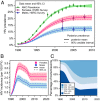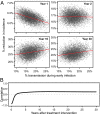Why the proportion of transmission during early-stage HIV infection does not predict the long-term impact of treatment on HIV incidence
- PMID: 25313068
- PMCID: PMC4234601
- DOI: 10.1073/pnas.1323007111
Why the proportion of transmission during early-stage HIV infection does not predict the long-term impact of treatment on HIV incidence
Abstract
Antiretroviral therapy (ART) reduces the infectiousness of HIV-infected persons, but only after testing, linkage to care, and successful viral suppression. Thus, a large proportion of HIV transmission during a period of high infectiousness in the first few months after infection ("early transmission") is perceived as a threat to the impact of HIV "treatment-as-prevention" strategies. We created a mathematical model of a heterosexual HIV epidemic to investigate how the proportion of early transmission affects the impact of ART on reducing HIV incidence. The model includes stages of HIV infection, flexible sexual mixing, and changes in risk behavior over the epidemic. The model was calibrated to HIV prevalence data from South Africa using a Bayesian framework. Immediately after ART was introduced, more early transmission was associated with a smaller reduction in HIV incidence rate--consistent with the concern that a large amount of early transmission reduces the impact of treatment on incidence. However, the proportion of early transmission was not strongly related to the long-term reduction in incidence. This was because more early transmission resulted in a shorter generation time, in which case lower values for the basic reproductive number (R0) are consistent with observed epidemic growth, and R0 was negatively correlated with long-term intervention impact. The fraction of early transmission depends on biological factors, behavioral patterns, and epidemic stage and alone does not predict long-term intervention impacts. However, early transmission may be an important determinant in the outcome of short-term trials and evaluation of programs.
Keywords: HIV incidence; HIV prevention intervention; antiretroviral therapy; early infection; mathematical model.
Figures





Comment in
-
Impact of early-stage HIV transmission on treatment as prevention.Proc Natl Acad Sci U S A. 2014 Nov 11;111(45):15867-8. doi: 10.1073/pnas.1418496111. Epub 2014 Nov 3. Proc Natl Acad Sci U S A. 2014. PMID: 25368195 Free PMC article. No abstract available.
-
Prevention of early HIV transmissions might be more important in emerging or generalizing epidemics.Proc Natl Acad Sci U S A. 2015 Mar 31;112(13):E1515. doi: 10.1073/pnas.1424168112. Epub 2015 Mar 3. Proc Natl Acad Sci U S A. 2015. PMID: 25737538 Free PMC article. No abstract available.
References
-
- Attia S, Egger M, Müller M, Zwahlen M, Low N. Sexual transmission of HIV according to viral load and antiretroviral therapy: Systematic review and meta-analysis. AIDS. 2009;23(11):1397–1404. - PubMed
-
- Granich RM, Gilks CF, Dye C, De Cock KM, Williams BG. Universal voluntary HIV testing with immediate antiretroviral therapy as a strategy for elimination of HIV transmission: A mathematical model. Lancet. 2009;373(9657):48–57. - PubMed
Publication types
MeSH terms
Substances
Grants and funding
LinkOut - more resources
Full Text Sources
Other Literature Sources
Medical

